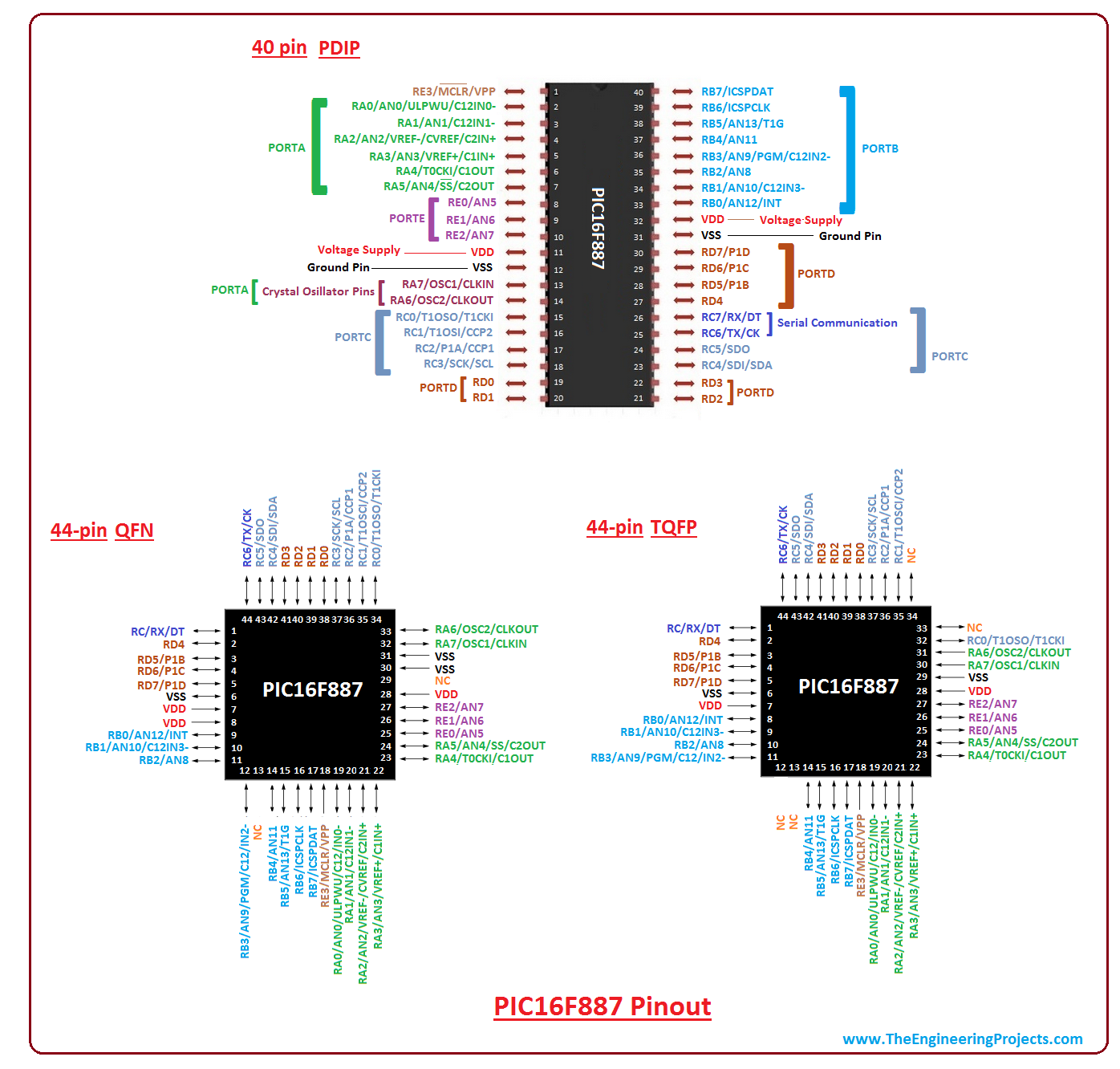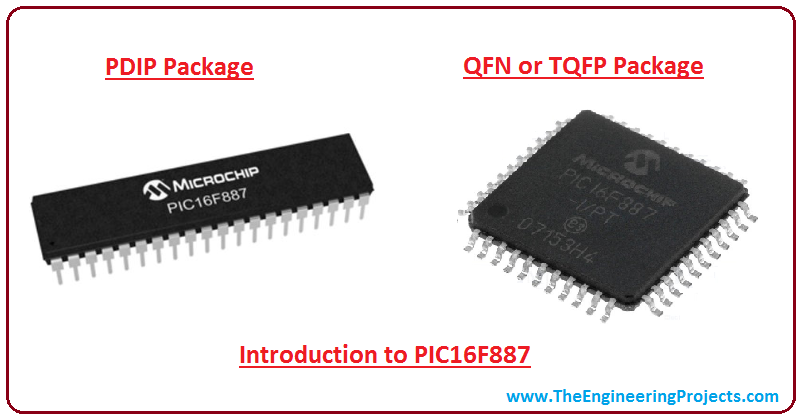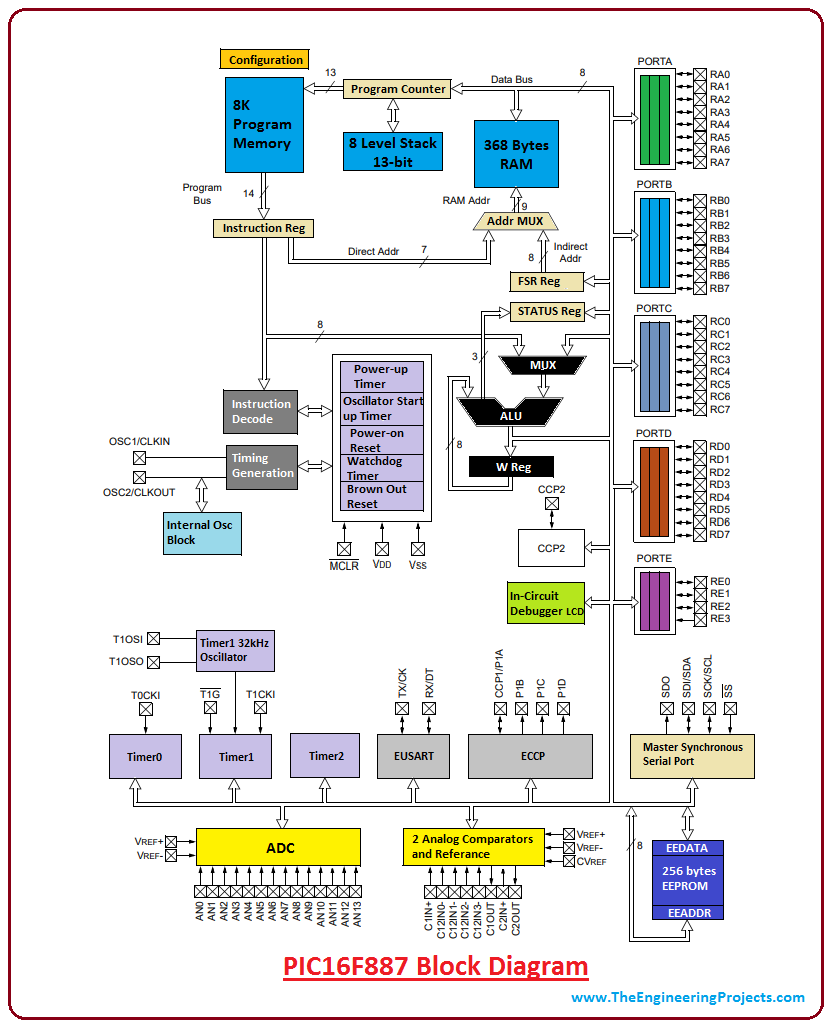
Introduction to PIC16F887
- PIC16F887 is a 40-pin (for PDIP package) and 8-bit CMOS PIC Microcontroller that comes with nanoWatt technology. Economical price and user-friendly architecture make this device easy to use and easy to configure.
- It is available in three packages known as PDIP, QFN, and TQFP. The first one comes with a 40-pin layout design while remaining two contains 44 pins on each layout.
- This PIC version, like other models in the PIC community, contains everything that is required to make an embedded system and drive automation.
- The PIC16F887 incorporates 256 bytes of EEPROM data memory, 368 bytes of RAM, and program memory of 8K.
- Apart from self-programming capability, it also contains 2 Comparators,10-bit Analog-to-Digital (A/D) converter with 14 channels, and capture, compare and PWM functions.

- The asynchronous serial port is added on the chip that can be configured both ways i.e. the 2-wire Inter-Integrated Circuit (I²C™) Bus or 3-wire Serial Peripheral Interface (SPI™)
- The Enhanced Universal Asynchronous Receiver Transmitter (EUSART) feature makes this chip compatible with the devices where serial communication is an integral part of the project.
- The functions that make this device unique in terms of ease of use include
- Power-Saving Sleep mode
- Industrial and Extended Temperature range
- Wide operating voltage range (2.0V-5.5V)
- SR Latch mode
- Power-up Timer (PWRT) and Oscillator Start-up Timer (OST)
- Power-on Reset (POR)
- Ultra-Low-Power Wake-up (ULPWU)
- Multiplexed Master Clear with pull-up/input pin
- Individually programmable weak pull-ups
- Brown-out Reset (BOR) with software control option
- Enhanced low-current Watchdog Timer (WDT)
- Needless to say, this PIC version is an ideal choice to drive A/D conversion in automotive, consumer, and industrial applications.
1. PIC16F887 Pinout & Description
Getting a hold of Pinout and Pin descriptions is mandatory to check the working of each pin on this tiny chip. If you are a newbie or an expert, you need to know the function associated with each pin for a better understanding of the chip.Pinout
The following figure shows the complete pinout of all three packages called PDIP, QFN, and TQFP.
- As described earlier, the PDIP package contains 40-pin while other two come with 44 pins.
Pin Description
PIC16F887 is widely used in many electronic applications. Some pins in the controller are capable of doing more than one functions that allow us to use the pin according to the needs and demands of the project. I have listed the function of each pin in the following table.| Pin# | Pin Name | Pin Description |
|---|---|---|
| 2 | RA0 AN0/ULPWU C12IN0- | Digital I/O Pin Analog Input 0 Pin Comparator |
| 3 | RA1 AN1/ULPWU C12IN1- | Digital I/O Pin Analog Input 1 Pin Comparator |
| 4 | RA2 AN2 C2IN+ VREF-/CVREF | Digital I/O Pin Analog Input 2 Pin Comparator ADC Reference Input Voltage (low) |
| 5 | RA3 AN3 C1IN+ VREF+ | Digital I/O Pin Analog Input 3 Pin Comparator ADC Reference Input Voltage (high) |
| 6 | RA4 C1OUT T0CKI | Digital I/O Pin Comparator External clock input for Timer0 |
| 7 | RA5 AN4 C2OUT SS | Digital I/O Pin Analog Input 4 Pin Comparator Slave Select input for SPI |
| 33 | RB0 AN12 IOC/INT | Digital I/O Pin Analog Pin Interrupt-on-change |
| 34 | RB1 AN10 C12IN3- IOC | Digital I/O Pin Analog Pin Comparator Interrupt-on-change |
| 35 | RB2 AN8 IOC | Digital I/O Pin Analog Pin Interrupt-on-change |
| 36 | RB3 AN9 C12IN2- IOC PGM | Digital I/O Pin Analog Pin Comparator Interrupt-on-change Basic |
| 37 | RB4 AN11 IOC | Digital I/O Pin Analog Pin Interrupt-on-change |
| 38 | RB5 AN13 T1G IOC | Digital I/O Pin Analog Pin Timer Interrupt-on-change |
| 39 | RB6 IOC ICSPCLK | Digital I/O Pin Interrupt-on-change pin Basic |
| 40 | RB7 IOC ICSPDAT | Digital I/O Pin Interrupt-on-change pin Basic |
| 15 | RC0 T1OSO/T1CKI | Digital I/O Pin Timer |
| 16 | RC1 T1OSI CCP2 | Digital I/O Pin Timer ECCP |
| 17 | RC2 CCP1/P1A | Digital I/O Pin ECCP |
| 18 | RC3 SCK/SCL | Digital I/O Pin MSSP |
| 23 | RC5/SDO RC5 SDO | Digital I/O Pin SPI Data-Out Pin |
| 24 | RC5 SD0 | Digital I/O Pin MSSP |
| 25 | RC6 TX/CK | Digital I/O Pin USART |
| 26 | RC7 RX/DT | Digital I/O Pin USART |
| 19 | RD0 | Digital I/O Pin |
| 20 | RD1 | Digital I/O Pin |
| 21 | RD2 | Digital I/O Pin |
| 22 | RD3 | Digital I/O Pin |
| 27 | RD4 | Digital I/O Pin |
| 28 | RD5 P1B | Digital I/O Pin ECCP |
| 29 | RD6 P1C | Digital I/O Pin ECCP |
| 30 | RD7 P1D | Digital I/O Pin ECCP |
| 8 | RE0 AN5 | Digital I/O Pin Analog Pin |
| 9 | RE1 AN6 | Digital I/O Pin Analog Pin |
| 10 | RE2 AN7 | Digital I/O Pin Analog Pin |
| 13 | RA7 OSC1 CLKIN | Crystal Oscillator Input Pin |
| 14 | RA6 OSC2 CLKOUT | Crystal Oscillator Output Pin |
| 1 | RE3 MCLR VPP | ICSP Programming Enable Pin Master Clear Active Low Reset Pin |
| 11,32 | VDD | Voltage Supply Pin |
| 12,31 | VSS | Ground Pin |
2. PIC16F887 Features
You can anticipate the nature of any device by looking at its main features. Following table shows the complete features of PIC16F887.| PIC16F887 Features | |
|---|---|
| No. of Pins | 40 |
| CPU | 8-Bit PIC |
| Operating Voltage | 2 to 5.5 V |
| Program Memory | 8K |
| Program Memory (Instructions) | 8192 |
| RAM | 368 Bytes |
| EEPROM | 256 Bytes |
| ADC | 10-Bit |
| I/O Ports (5) I/O Pins | A,B,C,D,E 35 |
| Packages | 40-pin PDIP 44-pin QFN 44-pin TQFP |
| External Oscillator | up to 20 MHz |
| Timer (3) | 16-Bit Timer (1) 8-Bit Timer (2) |
| USART Protocol | 1 |
| I2C Protocol | Yes |
| SPI Protocol | Yes |
| Brown-out Reset | Yes |
| Watchdog Timer | Yes |
| Comparators | 2 |
| Master Synchronous Serial Port (MSSP) module | 1 |
| Capture/Compare/PWM | 16bit/16bit/10bit |
| Power Saving Sleep Mode | Yes |
| Selectable Oscillator Option | Yes |
| Operating Current | 11uA at 32 kHz, 2.0 V 220uA at 4 MHz, 2.0 V |
| Temperature Range | -40 to 125 |
| Oscillator Start-up Timer | Yes |
- Checking main features before purchasing of the controller will help you analyze and develop your required project.
- Power on reset and selectable oscillator options are some unique features included in the chip.
3. PIC16F887 Functions
This PIC model performs many functions that are quite similar to the function in other controllers of the PIC community. Following are the main functions of PIC16F887.Timer
PIC16F887 contains one 16-bit timer and two 8-bit timers that can be used in both ways i.e. timer and counter and comes with internal and external clock select capability. The timer mode is used to increment the instruction cycle while counter mode increments the rising and falling edge of the pin. When the bit T0CS (OPTION_REG<5>) is set, the counter mode will be selected and when it is cleared, the timer mode will be selected.Brown Out Reset (BOR)
The BOR is a function that brings the controller to reset once the Vdd (voltage supply) drops below a brownout threshold voltage. There is a fine line between a BOR and Power On Reset, where the whole range of voltages is provided to protect the chip once the power drops at the voltage supply line. In order to put the delay, mostly recommended, in returning from a BOR function, the Power Up Timer must be kept enabled. Apart from controlling through software, the BOR mode can also be handled and configured through BOREN settings in a register.USART
PIC16F887 comes with enhanced USART module. This module consists of TX - A transmission pin used for transmitting serial data to other devices and RX - A receive pin used for receiving serial data.Watchdog Timer
PIC16F887 comes with built-in watchdog timer that is mainly used to reset the controller when a program hangs up during compilation or gets stuck in the infinite loop of the program. It is important to note the timer must be reset to the initial value after every 3 instructions in order to avoid it going to zero value in normal conditions. The watchdog timer is nothing but a countdown timer and starts from 1000 and gradually goes down to zero.Power On Reset
Power On Reset function resets the controller when it is powered on. If there comes unknown error in the chip, powering on the device will exclude it from the loop of running program and saves the device from malfunctioning.Sleep Mode
Power saving sleep function generates a low current power down mode. This sleep mode can be terminated using an interrupt, watchdog timer or external reset.4. PIC Compiler
- Microchip has introduced its own standard compiler for the PIC controller called MPLAB C18 Compiler. You can download this compiler online from the Microchip Official Site.
- The code written in the compiler creates a hex file that is transferred to the microcontroller to execute the certain function.
- Third party softwares are also available for compiling the program and MikroC Pro For PIC is mainly used for this purpose.
- These Top 3 PIC C Compilers give you the flexibility to pick any compiler based on your needs and requirements.
- The PICKit3 is mainly used for burning the code in the controller which is a standard PIC burner. There are other unofficial burners also available but PICKit3 is mostly preferred for the PIC controllers.
5. PIC16F887 Memory Layout and Working
The whole memory in this controller is distributed into three main types known as EEPROM, RAM and ROM Memory. All of them plays a vital role in the controller in terms of executing and calling instructions with some exceptions. Let's discuss each of them one by one.ROM Memory
ROM memory, also known as Non-Volatile memory, which stores the running program permanently and is not dependent on the power supply i.e. has an ability to retain the program if the power supply is removed. The ROM memory is about 8K made with FLASH Technology.EEPROM Memory
This memory is quite similar to ROM memory in one way or the other in terms of storing running program permanently with the exception i.e. the instructions in EEPROM can be modified during the operation of the controller. It contains memory space around 256 bytes, quite less than ROM memory, but enough to store the program permanently.RAM Memory
RAM memory, also known as volatile memory, is divided into two main parts known as general-purpose registers (GPR) and special-function registers (SFR). This memory is volatile in nature as it stores the program temporarily and is power dependent i.e. once the power supply is turned off the instructions stored in the RAM will be removed.- Registers in the RAM memory are the data holding places in the controller. A single register can hold instruction, storage address, and any kind of data including bit sequence or individual characters.
- Each bank contains128 bytes of memory space where first 12 locations are reserved for SFR while remaining are reserved for GPR.
6. PIC16F887 Block Diagram
The following figure shows the block diagram of PIC16F887.
- The program memory comes with 8K memory space which can configure 8192 words.
- Some pins can be interfaced with other functions of multiple devices including external interrupt, Timer0 clock input and Change on PORTB interrupt.
7. PIC16F887 Projects and Applications

- PIC16F887 is mainly used in students project i.e. controlling motors and sensor interfacing.
- Used in Central heating projects
- Production of temperature data logger
- Serial Communication
- Used in health and security systems
- Gas sensor projects
- Embedded system
- Used in industrial automation



